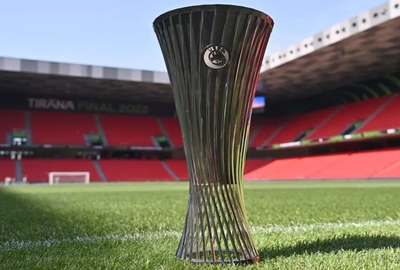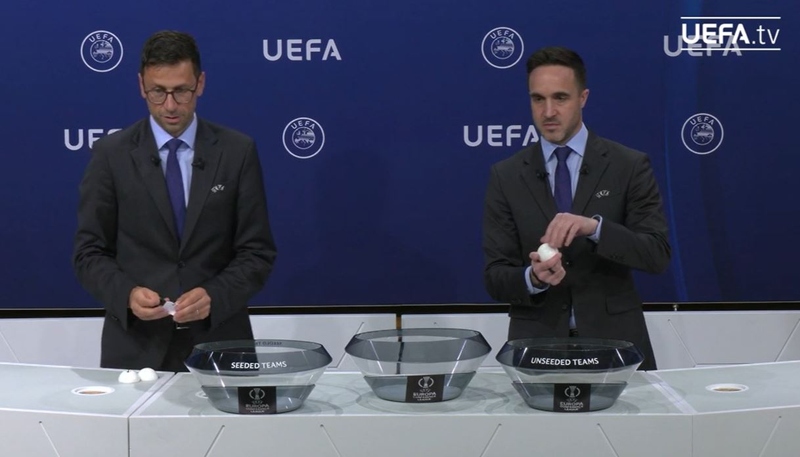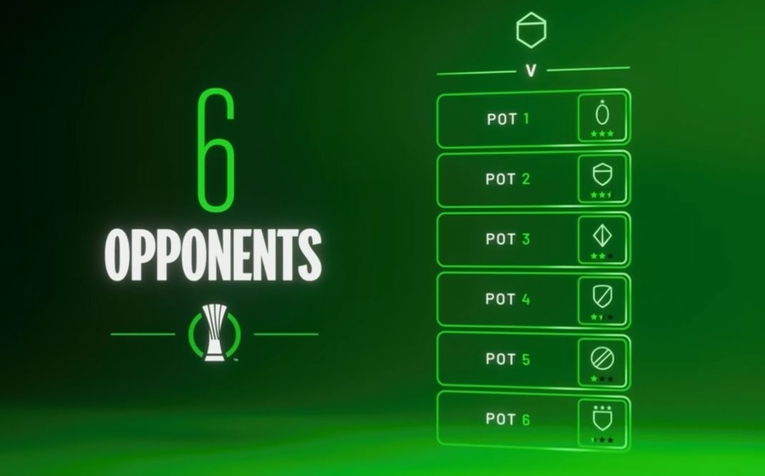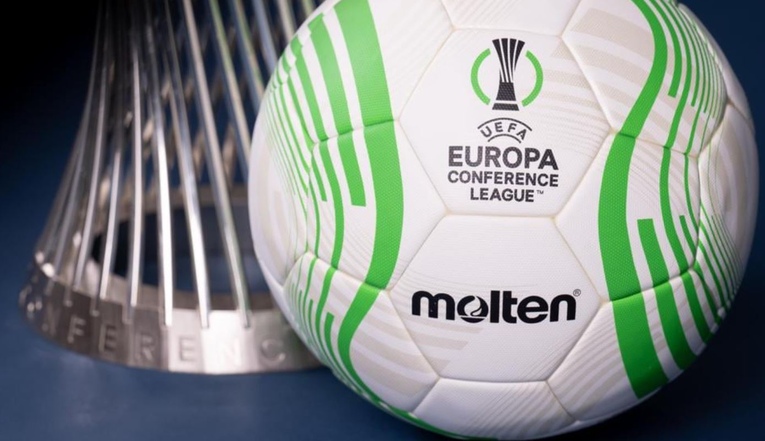Europa Conference League Stadiums & Stats
 UEFA never tires of re-inventing itself, constantly coming up with new tournaments or new formats for existing ones. So it is that the Europa Conference League came into existence ahead of the 2021-2022 season, offering smaller clubs another route to playing European football. As the name suggests, it is the lesser cousin of both the Champions League and the Europa League, making it the third tier competition.
UEFA never tires of re-inventing itself, constantly coming up with new tournaments or new formats for existing ones. So it is that the Europa Conference League came into existence ahead of the 2021-2022 season, offering smaller clubs another route to playing European football. As the name suggests, it is the lesser cousin of both the Champions League and the Europa League, making it the third tier competition.
The idea behind its origin was to give more clubs a taste of European football, especially those sides from countries that traditionally struggle to make it in to the Champions League and the Europa League. One might well wonder why English sides were therefore able to qualify for it, especially considering the first side that did so was Tottenham Hotspur, who narrowly beat Arsenal for the place.
The inaugural edition was won by Jose Mourinho’s Roma beating Feyenoord 1-0 at the Arena Kombëtare, Tirana, Romania. The second final was held at Slavia Prague’s Sinobo Stadium in 2023, and the venue changes from year to year. Despite being a brand new competition, the format was changed for the 2024-25 season in line with the Champions League and Europa League, replacing the group stages with a new league phase instead.
Europa Conference League Stadiums
| Stadium | Year Opened | Capacity | Ave Attendance | Record Attendance | Record Attendance Match |
|---|---|---|---|---|---|
|
Stamford Bridge
Chelsea FC |
1877 | 40341 | 39576 | 82905 | Cheslea v Arsenal (1935) |
Final
| Fixture | Date & Time | Stadium | ||
|---|---|---|---|---|
 ? ? | v |  ? ? | Wed 28th May | Wrocław Stadium |
Tournament Format
Overall Structure
At most stages in the competition, teams play 2 legs in order to determine a winner. The only times when this is not the case is during the league stage, and in the final itself.
New teams enter the competition at different stages, and from different pathways too.
I will go into detail about each stage of the Conference League shortly, but first, here is the overall structure.
| Round | New Teams Entering | Teams from Previous Round | Teams Total | No Fixtures |
|---|---|---|---|---|
| First Qualifying Round | 50 | – | 50 | 50 |
| Second Qualifying Round (C) | 14 | – | 14 | 14 |
| Second Qualifying Round (L) | 61 | 25 | 86 | 86 |
| Third Qualifying Round (C) | 1 | 7 | 8 | 8 |
| Third Qualifying Round (L) | 9 | 43 | 52 | 52 |
| Play-Off (C) | 4 | 6 | 10 | 10 |
| Play-Off (L) | 12 | 26 | 38 | 38 |
| League Stage | 12 | 24 | 32 | 192 |
| Last 16 | – | 16 | 16 | 16 |
| Quarter Finals | – | 8 | 8 | 4 |
| Semi Finals | – | 4 | 4 | 2 |
| Final | – | 2 | 2 | 1 |
KEY: C = Champions Path, L = League Path
Qualification Rounds

Throughout the qualification stages, 165 different teams compete for a place in the league stages.
In order to qualify for the Europa Conference League, clubs need to either do well in their domestic league or else one of the domestic cups. As is often the case, UEFA have worked hard to make qualification as convoluted as possible, offering ‘two paths’ for qualification: the Champions Path and the League Path. The Champions Path is a slightly misleading title, given it’s for teams that lose their Europa League or Champions League group stage qualification matches, then drop down into the Conference League.
The number of teams from each league is decided upon according to the UEFA country coefficients rankings:
- Rank 1 to 2 – 1 team
- Rank 13 to 34 – 2 teams
- Rank 35 to 50 – 3 teams
- Rank 51 to 55 – 2 teams
The only odd one out here is Liechtenstein, who don’t have a domestic league, so the winner of the Liechtenstein Football Cup gains qualification, regardless of their coefficient ranking.
One of the key things about the introduction of the Europa Conference League is that other leagues were reorganised in order to ensure that no country would get more berths than they had before its invention. Instead, the Conference League simply took the place of the lower qualification berths of the Europa League. So now they enter this secondary tournament rather than struggling in the qualification rounds of the Europa League.
The specifics of exactly which teams enter the qualifying rounds of the Europa Conference League and when are as follows:
- 1st Qualifying Round – 9 domestic cup winners from associations 47–55, 21 domestic league runners-up from associations 34–55, and 20 domestic league third-placed teams from associations 30–50.
- 2nd Qualifying Round – 13 domestic cup winners from associations 34–46, 17 domestic league runners-up from associations 16–33, 15 domestic league third-placed teams from associations 13–29, 9 domestic league fourth-placed teams from associations 7–15, and 1 domestic league fifth-placed team from association 6.
- 3rd Qualifying Round – No new domestic teams entered
- Play Off Round – 5 domestic league sixth-placed teams from associations 1–5 (EFL Cup winners for England)
You may be wondering where the other teams come from to make up to 165 team total. These filter down from the Europa League, and a few even come in from the Champions League too.
Here’s how it works:
- 2nd Qualifying Round – 14 teams eliminated from Champions League first qualifying round, and 6 teams eliminated from Europa League first qualifying round.
- 3rd Qualifying Round – 1 team eliminated from Champions League first qualifying round, and 9 teams eliminated from Europa League second qualifying round.
- Play Off Round – 6 teams eliminated from Europa League third qualifying round (Champions path), and 7 teams eliminated from Europa League third qualifying round (League path).
A further 12 teams who were eliminated from the Europa League playoff rounds skip the qualifying rounds altogether and jump straight in at the League Stage.
League Stage

The format of the Europa Conference League changed from 2024/25 onwards, and the group stage was replaced by a league stage.
36 teams make it into the league stage of the competition, and they are divided into 6 pots. The pots each team goes into depend on their association ranking with UEFA, then every team plays one team from each pot.
You can think of the pots as ‘difficulty ratings’ if you like. Pot 1 will be the teams from the highest ranking associations, and Pot 6 will be those from the lowest. By playing one team from each pot, all teams in the league get an equal experience in terms of the strength of opposition they will face.
Once all games have been played, the top 8 teams in the league are automatically sent through into the first of the knockout rounds, while the next 16 go into a playoff, before the winning 8 teams from that playoff join the automatic qualifiers in the Round of 16.
Knockout Rounds

You might think that once the competition had progressed to the knockout rounds things would be relatively simple, but we aren’t quite there yet.
The knockout bracket is structured in such a way to give the top performing teams so far the easiest route to the final. So the team that finished top in the League Stage will face a team that got through via the playoffs. The top 8 teams are also split across the bracket, so they will not face each other in the Round of 16.
The competition reverts back to 2 leg fixtures at this point, and the overall winner of each game in the Round of 16 progresses to the quarter finals, at which point things do finally become simpler. After the Quarter Finals come the semi-finals, before the final two remaining teams face each other in the final, which is decided by a single game rather than across 2 legs.
The winner will gain a place in the Europa League for the following season, on top of winning the Europa Conference League Cup.
Previous Winners
| Host City | Year | Winner | Stadium |
|---|---|---|---|
 Wrocław Wrocław |
2025 | ? | Wrocław Stadium |
 Athens Athens |
2024 | Olympiacos | Agia Sophia Stadium |
 Prague Prague |
2023 | West Ham | Sinobo Stadium |
 Tirana Tirana |
2022 | Roma | Arena Kombëtare |
British Club Performance
| Club | Cups | Runners Up | Played | Wins |
|---|---|---|---|---|
| Aston Villa | 0 | 0 | 13 | 8 |
| West Ham | 1 | 0 | 15 | 14 |
| Tottenham | 0 | 0 | 8 | 3 |
| Leicester City | 0 | 0 | 8 | 4 |
Europa Conference League Stats
| Tournament Stats | |
|---|---|
| First Year | 2021-22 |
| Titles (Nation) | Italy (1), England (1), Greece (1) |
| Titles (City) | Rome (1), London (1), Athens (1) |
| Highest Overall Attendance | 2,077,952 (2022-23) in 141 matches |
| Prize Money Winner | €5.0 million (2024) |
| Group Stage Base Fee | €650,000 (2024) |
| Qualifying Teams | 165 |
| Final Teams | 36 |
| Club Stats | |
|---|---|
| Titles | Roma, West Ham, Olympiacos - 1 |
| Runner Up | Fiorentina - 2 |
| Consecutive Appearances | Multiple - 3 |
| Undefeated champions | West Ham (2023) |
| Consecutive Wins | No Team More Than 1 |
| Biggest Win One Game | 7-0 (Several - 2022 & 2023) |
| Biggest Aggregate Win | 11-0 (Slavia Prague - St Joseph's - 2022) |
| Most Goals In A Game | 8 (Several - 2022 & 2023) |
| Player Stats | |
|---|---|
| Highest Scorer | Arthur Cabral (Basel & Fiorentina), Vangelis Pavlidis (AZ Alkmaar), Eran Zahavi (Maccabi Tel Aviv) - 12 |
| Most Goals In A Season | Cyriel Dessers - 10 (Feyenoord) |
| Most Goals In A Game | Harry Kane, Gaëtan Laborde, Nicolò Zaniolo, Morales, Gift Orban, and more - 3 |
| Fastest Goal | Ferdy Druijf - 32 seconds (Rapid Wien) |
| Oldest Player | Pepe Reina - 40y 197d (Villareal) |
| Oldest Scorer | Milan Petržela - 39y 89d (Slovácko) |
| Youngest Player | Ayyoub Bouaddi - 16y 3d (LOSC Lille) |
| Youngest Scorer | Marko Milovanović - 18y 127d (Patizan) |
About the Europa Conference League

Reports suggest that UEFA had toyed with adding a third-tier European competition to their roster since 2015. The logic behind such a move was that it would give clubs that ply their trade in countries with a lower coefficient ranking a chance to play European football. Given that they typically tend to be eliminated from the Champions League and the Europa League at the early stages, it would also provide an opportunity to progress to a competition’s latter stages.
In the middle of 2018, talk about launching such a competition intensified. Some sources claimed that an agreement had already been reached for the launching of such a tournament, with the Europa League split into two in order to accommodate it. On the 2nd of December 2018, UEFA confirmed the competition’s existence, giving it the provisional name of the Europa League 2. The idea was that it would be launched as part of a three-year competition cycle.
The 24th of September 2019 saw the competition given its official title of the UEFA Europa Conference League, with the organisation saying that it would bring ‘more matches for more clubs and more associations’. The competition’s trophy and branding was officially announced on the 24th of May 2021.
Roma won the first ever ECL beating Feyenoord by a single goal in the final held at the Arena Kombëtare in Tirana (Romania). Of course it had to be Jose Mourinho who won it maintaining the amazing stat of winning all 5 European finals he has been involved in and bringing home the first European trophy for Roma.
West Ham became the first British club to win the trophy in 2023 beating Fiorentina 2-1 in the final in Prague. It was the first European trophy for the London club since their Intertoto cup win in 1999.
The Trophy

Those with only a passing intertest in football would be forgiven for confusing the Europa Conference League trophy and the Europa League trophy, given that they bear a slight resemblance to one another.
Standing at 57.5cm tall and weighing 11kg, the trophy is made up of 32 hexagonal spines, which are supposed to represent each of the teams that make it the competition’s group stage.
Presumably the designed shrugged to incorporate the other eight teams that join the competition before the knockout stage proper gets underway.
UEFA’s nonsense corporate speak suggests that the curved nature of the spines were ‘inspired by the fight of a football heading towards a goal. The base and the top, meanwhile, are made of hand-brushed brass compared to the silver finish of the spines.
